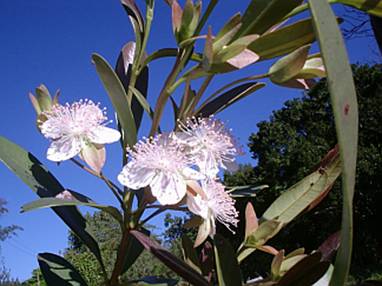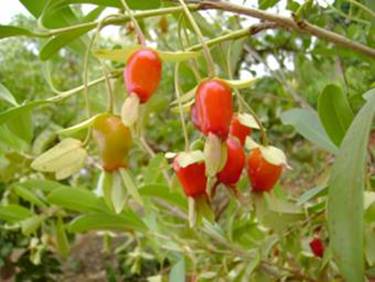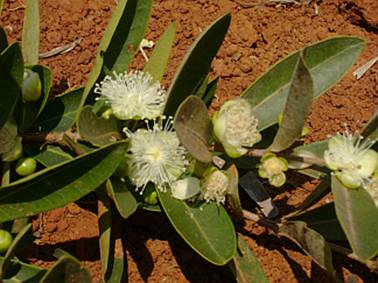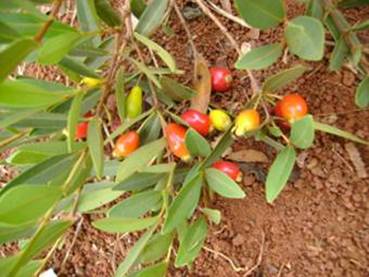EUGENIA CALYCINA UND EUGENIA PUNICIFOLIA
FAMILIE MYRTACEAE
|
FLOWERS OF EUGENIA CALYCINA |
FRUITS OF EUGENIA CALYCINA |
|
FLOWERS OF EUGENIA PUNICIFOLIA |
FRUITS OF EUGENIA PUNICIFOLIA |
NOMENCLATURE AND IMPORTANCE: CA-AJABOTÍ comes from the Tupi-Guarani and means “herb whose fruit gives Jaboti”. Also known as savanna cherry, field cherry, Jabuti cherry and Grão de galo.
Origin: The Eugenia calycina isnative to the savannah, is found almost on muddy fields and shrub savannah in the states of Goiás, Minas Gerais, in the south west and north of the state of São Paulo and in Mato Grosso do Sul. The Eugenia punicifolia has one larger area of distribution in most Brazilian states and other South American countries. More information in Portuguese at the link:
Features: The E. calycina grows to 80 to 1.60 cm high, the trunk is elliptical (with ascending branches), yellowish-gray and smooth, the leaves are oblong and the flowers are pink, and the fruits have two bracts (modified leaves) at the base. The E. punicifolia grows as a creeping shrub (with low-lying branches), reaches a height of 20 to 50 cm, with brown, networked shoots. Leaves are narrow or wide with leathery texture, the flowers are white and the fruits without the red bracts. According to the description above, the major differences between the two species spend the systematic description: The stems are cylindrical or slightly flattened, sometimes glabrous (hairless), sometimes pubescent (covered by) trichomes (long hair), which may be sparse, reddish or whitish. The leaves are oblong (longer than wide), with a texture like cardboard and reddish when young, always leathery, in the mature state, they do not stain themselves, or bright green on top and yellowish cream color on the bottom or opaque green in the species E. punicifolia. The blade measures 3 to 12 cm in length and 1.6 to 3.2 cm in width. The flowers of Eugenia calycina arise to new settlements on the side or edge among the stalks, flowered from 1.5 to 5.8 cm long, with 2 bracteoles, which are 0.9 to 2.2 cm long, ovate and based cordate with pointed tip. The flowers of Eugenia punicifolia always appear in pairs in the leaf axils, on stalks 0.9 to 2.6 cm in length.
Culture Tips: They can be grown in full sun from sea level to altitudes of 1600 m. They tolerate semi-arid climate, rainy temperate, subtropical dry and wet rainy to tropical climate. They tolerate frost to -4 ° C and maximum 42 ° C. They tolerate different soil types, can be sandy-loamy and sandy soil with quartz for E. calycina and red and fertile soil, brown soil (sandy loam with stones) and even rocks for E. punicifolia. The pH can range from 4,5 to 6.7, some moisture for the first species and with rapid removal of water for the second species.
Propagation: The seeds are recalcitrant (lose their ability to germinate quickly). The best substrate for sowing is 40% red soil, 30% river sand (white) and mix 30% organic matter well. It must be used by bag of 15 to 30 cm depth of the deep-rooted root system of these species. 2 seeds per bag are to sow, put into direct sun and water well in the late afternoon. Germination of E. calycina occurs in 30 to 45 days and seedling growth is rapid, reaching 20 cm in 10 months after germination, and the germination of E. punicifolia takes longer occurs in 65 to 100 days, and the growth of seedlings is slowly and the seedlings reach 7 cm 12 months after germination.
Planting: Can be planted in full sun in space at a distance of 3 x 3 meters, the hole should measure the depth, width and length of 50 cm each, should be filled 30 cm of well-mixed, fertile soil in 18 liter gritty sand, 4 kg of well mixed manure, 200 g of lime and 1 kg of wood ash. Leave in for 2 months and do the planting from October to December. After planting pour with 10 liters of water and then pour once a month when it is not raining. Use for planting in pots (50 cm high and 40 cm wide) red soil and the same mixture as above, it must be ensured that a 4 cm drainage layer is placed on the bottom of the pot to ensure a rapid withdrawal.
Culture: The plant grows quickly and requires no special care, just regular weeding, so that the plant is not stifled. Remove the crossed branches that grow from the lump. In August, before blossoming fertilize with the distribution of 20 g NPK 10-10-10 and 2 kg of compost, as already mentioned in the distance of 20 cm from the main stem, 6 inches deep and 10 inches wide.
Use: They will fruit from November to January. The fruits of E. calycina are refreshing and rich in vitamin A and can be consumed in natura. The pulp of the both species can be used normally in the form of juices, jams, jellies and ice cream to be consumed for a special taste. Both types can be used for landscaping projects.
Back to the seedlist (English) or back to Myrtaceae (Portuguese)



